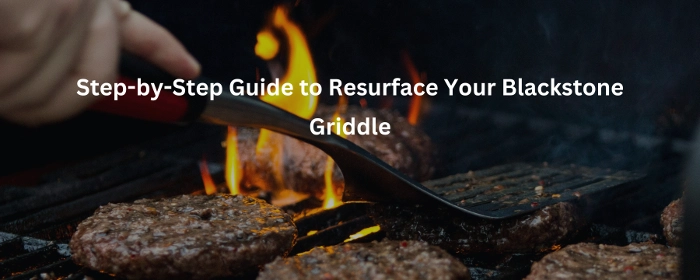Step-by-Step Guide to Resurface Your Blackstone Griddle

-
Understanding Rust on Blackstone Griddles
-
Preparing for Resurfacing
-
Removing Rust and Cleaning the Griddle
-
Re-Seasoning Process
-
Restoring Performance and Preventing Future Rust
-
Common Mistakes to Avoid
-
Conclusion
If you love cooking on your Blackstone griddle, keeping it in top shape is essential.
Over time, rust can develop and impact your griddle’s performance.
But don’t worry!
Resurfacing your griddle is simpler than it sounds.
Here’s a step-by-step guide to help you remove rust and restore your griddle’s performance, with some handy tips along the way.
Understanding Rust on Blackstone Griddles
Rust is a type of corrosion that happens when iron or steel meets oxygen and moisture.
On your Blackstone griddle, rust can damage the metal surface and affect how well it cooks.
It’s important to tackle rust as soon as you spot it to prevent further damage.
Regular maintenance is key to keeping your griddle in great shape and extending its life.
Read More: Best Way to Clean a Blackstone Griddle: Step-by-Step Guide
Preparing for Resurfacing
Before you start resurfacing your griddle, you need to clean it thoroughly.
Here’s how to get ready:
Deep Cleaning: Start by cleaning your griddle with warm, soapy water and a non-abrasive pad or grill brush. This removes loose debris and initial rust. The Easy Function bristle brush is a great tool for this job. It’s designed to provide heavy-duty cleaning without the risks associated with traditional wire brushes. Plus, it conforms to the grill grates, making your job easier.
Rust Removal Solution: Mix equal parts water and white vinegar in a spray bottle. Spray this solution on the rusted areas and let it sit for 10-15 minutes. Then, scrub the area with a non-abrasive pad or grill brush. The vinegar helps dissolve the rust and make it easier to scrub away.
Baking Soda Paste: Create a paste by mixing baking soda with water. Apply this paste directly to the rusted areas and let it sit for about 30 minutes. Scrub with a non-abrasive pad or grill brush to remove stubborn rust. The baking soda paste is mildly abrasive and helps lift away the rust effectively.
Removing Rust and Cleaning the Griddle
Once you’ve tackled the rust, it’s time to clean and prepare the griddle for resurfacing:
Applying Oil: After cleaning, apply a thin layer of cooking oil to the griddle’s surface. Heat the griddle until it begins to smoke. This process seasons the griddle, creating a protective layer that prevents rust and improves its non-stick properties.
Using a Rust Converter: Consider using a rust converter to turn any remaining rust into a stable, inert substance. This makes it easier to resurface your griddle and prevents the rust from spreading.
Sanding: Use coarse-grit sandpaper to sand the griddle, removing any remaining rust and smoothing out the surface. Wipe the griddle clean with a cloth, then apply a rust-inhibiting coating.
Related Read: Easy Guide to Removing Rust from Your Blackstone Griddle
Re-Seasoning Process
To keep your griddle performing well, you need to re-season it:
Applying the Seasoning: Apply a thin layer of cooking oil to the griddle and heat it until it begins to smoke. This seasoning process creates a protective layer. For an extra boost, use a seasoning paste designed for griddles. Apply it evenly across the griddle’s surface.
Curing the Seasoning: Heat the griddle to high heat to allow the seasoning to cure and polymerize. Let the griddle cool completely before wiping off any excess seasoning with a paper towel. Repeat the seasoning process 2-3 times to achieve a durable, non-stick surface.
Restoring Performance and Preventing Future Rust
Once your griddle is resurfaced, it’s important to maintain it:
Regular Maintenance: Regular cleaning and re-seasoning help prevent rust. Using a product specifically designed for grill protection offers better results than regular cooking oil.
Proper Storage: Always cover your griddle to protect it from weather elements. Storing it in a shed or garage during extreme weather conditions helps prevent rust spots.
Common Mistakes to Avoid
To keep your griddle in great condition, avoid these common mistakes:
Using Abrasive Cleaners: Avoid abrasive cleaners or scouring pads that can scratch the surface of your griddle.
Not Drying Thoroughly: Make sure to dry your griddle thoroughly after cleaning. Leaving it wet can lead to water spots and rust formation.
Neglecting Re-Seasoning: Regular re-seasoning is crucial for maintaining non-stick performance. Don’t skip this step.
Improper Storage: Improper storage can lead to rust formation. Ensure your griddle is well-covered and stored properly.
Conclusion
Resurfacing a Blackstone griddle is a straightforward process that involves the right tools and techniques.
By following these steps, you can effectively remove rust and restore your griddle’s performance.
Regular maintenance and proper storage will keep your griddle in excellent condition for years to come.
For routine care and cleaning, consider using the Easy Function wood grill scraper.
It’s eco-friendly and conforms to the shape of your griddle over time, making it an excellent choice for maintaining your griddle.
For deep cleaning, our bristle-free brushes offer a safe and effective way to keep your griddle spotless.
Happy grilling!
-
Understanding Rust on Blackstone Griddles
-
Preparing for Resurfacing
-
Removing Rust and Cleaning the Griddle
-
Re-Seasoning Process
-
Restoring Performance and Preventing Future Rust
-
Common Mistakes to Avoid
-
Conclusion
